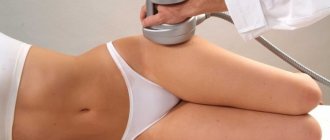Firm, rounded buttocks are an attractive part of the body for a person of any gender and age. You can deny this fact as much as you like, but animal instincts will always force us to pay attention to this “detail” of our own and others’ figures.
Everyone has different tastes. Some people like “butts like a nut”, others like round and soft ones. In recent years, there has even been a certain cult of buttocks - spherical and hard, like bowling shells. To achieve this ideal, people, especially women, are willing to literally live in gyms.
However, not everyone can train fiercely for months to achieve the perfect body. And it’s not always possible to pump up your “dream butt” with squats. If by nature a person is given one shape of buttocks, but he dreams of a completely different one, the situation cannot be corrected without outside intervention.
In such a situation, only surgery can help - buttock plastic .
1
Consultation with a plastic surgeon
2 Plastic surgery for buttock correction
3 Plastic surgery for buttock correction
Why is buttock surgery performed?
The roundness and elevation of the buttocks are ensured by dozens of muscles and ligaments, not only the gluteal ones, but also partly the femoral ones. Over the years, the muscles in this area sag, resulting in a deterioration in shape and volume. The situation can be corrected surgically.
The buttock lift procedure helps eliminate sagging soft tissues and correct cosmetic skin defects. However, if the goal is to reshape and add volume to flat buttocks, a more radical operation called gluteoplasty . The essence of this surgical intervention is the correction of the buttocks using silicone implants.
Indications for buttock surgery:
- scars, stretch marks and other skin defects of the buttocks;
- loss of volume, ptosis of soft tissues, sagging skin in the area;
- congenital or acquired asymmetry and deformation of the buttocks;
- flat buttocks, unaesthetic shape of the buttocks.
Preparation for surgical correction of the buttocks
You should start preparing with a consultation with a plastic surgeon. After conducting an examination, the doctor will listen to the patient’s complaints and wishes, make suggestions on the surgical technique, and report on the method of anesthesia.
Next, you need to undergo preoperative diagnostics. This is a mandatory step for every surgical procedure and allows you to identify health problems that may interfere with surgery.
The list of contraindications to buttock surgery includes:
- malignant processes;
- diabetes;
- heart and vascular diseases;
- bleeding disorders;
- infections of various origins;
- pregnancy, lactation, etc.
Types of buttock surgery
The method of correction of the buttocks is determined in accordance with the task, the volume of impact, and the physical parameters of the patient.
There are several ways:
- buttock lift (without endoprosthetics).
- gluteoplasty (shape correction, buttock augmentation with implants;
- thread correction of the buttocks.
Surgical butt lift
There is no universal surgical access for plastic surgery of the gluteal region. The incision area is determined by the purpose of the intervention. So, to correct drooping, long, asymmetrical buttocks, a median (medial) or lower incision is made. For trochanteric sagging, it is more effective to use a lateral or superior incision (Pascal's incision).
Through the incision, the plastic surgeon excises excess soft tissue, tightens and fixes the muscles, then closes the incision area with cosmetic sutures. If necessary, the lifting procedure can be performed simultaneously with liposuction or with surgery on the outer or inner thighs (buttock and thigh lift).
The operation is performed under general or local anesthesia for 2-2.5 hours.
A butt lift provides a significant rejuvenation effect in a given area, maintaining the result for 10 years or more (in the absence of weight fluctuations). However, the method also has significant disadvantages: long recovery, postoperative scars, for example, the inability to correct the shape of flat or severely drooping buttocks.
Buttock surgery. Photo before:
1 Before buttock surgery
2 Before buttock surgery
3 Before buttock surgery
Buttock surgery. Photo after:
1 After buttock surgery
2 After buttock surgery
3 After buttock surgery
Buttock enlargement
The gluteoplasty technique involves the use of silicone implants. They are round, oval and teardrop-shaped (anatomical). Round and oval endoprostheses are well suited for enlarging the buttocks and giving them roundness. Anatomical implants are chosen when it is necessary to correct aesthetic defects (asymmetry, deformation of the buttocks).
The implant is installed through a small incision in the sacral area in the natural intergluteal fold. The endoprosthesis is placed under the muscle that holds it and does not allow it to move along the buttock, or under the superficial gluteal fascia to ensure maximum naturalness. Buttock surgery is often combined with liposuction and hip correction (this technique is also called body lift).
After placing the endoprostheses, the surgeon places cosmetic sutures on the incisions (usually self-absorbable material is used) and, if necessary, installs drainage.
The operation takes about 1.5-2 hours and is done under general anesthesia.
Buttock lift with threads
A thread lift, often called a Brazilian lift, is used in cases of slight ptosis of soft tissues and skin and in the presence of cellulite.
Through micropunctures, threads are placed under the skin using cannulas, which are fixed in the soft tissues using special notches or cones. After installing the threads, the surgeon tightens the soft tissue to them and secures them in a new position. If necessary, a thread lift is combined with lipofilling or liposuction.
The intervention is performed under local anesthesia for 1 hour.
The advantages of the method include quick rehabilitation and the absence of scars. The disadvantages are the short duration of the effect (from 3 to 5 years).
Will fitness help? Ptosis of the buttocks.
The appearance of the buttocks directly depends on the thickness, evenness and smoothness of the fat layer that lies under the skin.
With age, under the influence of many unfavorable factors, the fat layer and the skin above it undergoes a number of changes and transformations: it goes down, increases or decreases in size.
Among the unfavorable factors are:
- sedentary lifestyle, lack of physical activity;
- bad habits;
- sudden weight fluctuations;
- natural gravity, gravity.
As a result, the buttocks sag. In medicine, this phenomenon is called ptosis.
Ptosis is a drooping of the soft tissues (adipose tissue, collagen components, skin) located on the surface of the gluteal muscles, above the subgluteal ligament, which is the bridge between the buttock and the thigh.
Ptosis is easily diagnosed by its appearance: the center of the buttocks shifts downward, and a clearly defined subgluteal fold appears. In addition, the presence of ptosis is well determined by the appearance of the buttocks in profile.
There are several stages and degrees of buttock ptosis:
In the absence of ptosis, the gluteal fold is not visible or may reach the line of the ischial tuberosity, and the angle formed between the overhanging buttock and the thigh should not be more than 90 degrees.
Let's look at the stages of ptosis.
1. Minimal preptosis
With minimal preptosis, the gluteal fold crosses the line of the ischial tuberosity without reaching the midline of the thigh.
2. Moderate preptosis
When the gluteal fold reaches the midline of the thigh without crossing it, moderate preptosis is said to be present.
3. Borderline preptosis
If the gluteal fold crosses the midline of the thigh, then we are dealing with borderline preptosis.
4. True ptosis of the buttocks
We speak of true ptosis when there is a pronounced gluteal fold that crosses the midline of the thigh at a considerable distance.
Degrees of ptosis
The degree of ptosis of the buttocks is determined using a ruler.
First degree
With the first degree of ptosis, the gluteal fold descends by about 5 cm of the subgluteal groove;
Second degree
With the second degree of ptosis, the gluteal fold drops 1 cm below the subgluteal groove;
Third degree
With the third degree of ptosis, the gluteal fold drops 2 or more centimeters below the groove under the buttocks.
Ptosis can even occur in athletes. By pumping up your pelvic muscles, you increase their weight and size. Weight makes the fold more pronounced.
Thus, buttock ptosis cannot be corrected in the gym. Only aesthetic medicine can solve this problem.
After buttock surgery
After surgical correction of the buttocks, pain and decreased sensitivity may persist in the intervention area for 2-3 days. No sitting is allowed for at least 7 days.
After 14 days, the patient can return to their normal lifestyle. However, you should refrain from physical exercise for at least 1.5 months. And it is recommended to wear special compression garments for at least the same amount of time.
MedicCity offers a full range of plastic surgeries and cosmetic procedures for the face and body. Our plastic surgeons are recognized masters of their craft, professionals of the highest class! The cost is average in Moscow. If you are choosing a specialist to whom you want to entrust the correction of your buttocks, read reviews of the clinic’s plastic surgeons.
Toned buttocks: nutrition, training, pumping methods
To get beautiful, toned buttocks, you need to know the specifics of anatomy. The buttocks include the small, medium and large muscles, the last of which is the most voluminous and is involved in hip extension.
Proper nutrition for building buttocks
First you need to create the right diet: switch to a five-course diet with small portions. This diet includes greens, vegetables and fruits, lean meat and fish, legumes, cottage cheese and dairy products. In simple words – proteins and fiber.
Regular still water should be consumed at least two liters per day, as well as walking and jogging. The duration of sleep should be at least eight hours. This will help keep your body in good shape.
If you exercise at home, then do everything gradually and for 15-20 minutes a day, otherwise the risk of pinching the sciatic nerve increases due to excessive physical exertion with lifting weights.
Time spent on toned buttocks
It depends on age and body composition. For some, a few months are enough, for others up to six months. Long breaks between workouts and poor nutrition are the key to failure. Regular exercise, diet and a well-developed daily routine will help speed up the pumping process.
These workouts can also be combined with other sports:
- Jogging. It actively burns fat and helps strengthen the buttocks due to the mobility of the hips;
- Cycling. Riding on it puts a lot of stress on all the gluteal muscles. What is important here is not the speed of movement, but the duration;
- Skis. Skiing brings enormous benefits and strengthens absolutely all muscles. The step width should be maximum;
- Swimming. When a person swims, the muscles of the buttocks are subject to heavy load. It will increase if the hands are not involved in this, and alternately swinging the legs up and down and to the sides will have a huge weight in pumping up the buttocks;
- Skates and rollers. They provide active mobility of the hips and pelvis, toning the gluteal muscles. They also burn extra calories;
- Pilates. It contains exercises for all parts of the body;
- Eastern Latin American dances. The impressive load placed on the hips and buttocks brings enormous benefits.
Exercises for pumping up the buttocks in fitness clubs
It is much easier to pump up your buttocks in the gym. There are special simulators that make classes more effective.
Before you start doing the exercises, you need to warm up your muscles and joints. This can be done on an exercise bike or treadmill for ten minutes.
The Smith machine is a device designed to strengthen the gluteal muscles. In simple words, this is a machine that allows deeper squats with a barbell. But you don’t need to overdo it, wanting to get elastic buttocks right away, otherwise you may end up with a sprained ligament, which will make training very painful.
The most popular exercise for pumping up the buttocks is spreading the legs in different directions while standing on a stepper, which must be performed at least ten times in one approach.
Another effective exercise is swinging your legs to the sides, secured in sports weights. It must be repeated 10-12 times with each leg.
The next step is a machine with stepper functions, a treadmill or an exercise bike. They can pump up not only the muscles of the legs and thighs, but also the upper limbs.
How to effectively pump up your buttocks at home
You can pump up elastic buttocks at home by working out at least twice a week.
Lunges are performed with dumbbells, lowering your arms along the body and standing straight, bending slightly at the waist. Tighten your abs and place your legs together, and then transfer the weight of your entire body to the entire leg and sit down on it so that you get an angle of 90 degrees. Change leg. Such lunges are usually done 12-15 times. Author: K.M.N., Academician of the Russian Academy of Medical Sciences M.A. Bobyr









